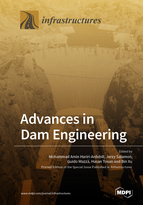Advances in Dam Engineering
A special issue of Infrastructures (ISSN 2412-3811).
Deadline for manuscript submissions: closed (30 January 2020) | Viewed by 58440
Special Issue Editors
2. College of Computer, Mathematical and Natural Sciences, University of Maryland, College Park, MD 20742, USA
Interests: advanced analysis of infrastructures; earthquake engineering; scientific machine learning; coupled systems mechanics; uncertainty quantification and resilience
Special Issues, Collections and Topics in MDPI journals
Interests: concrete dams; appurtenant structures for dams; seismic analysis; finite element analysis; nonlinear models
Special Issues, Collections and Topics in MDPI journals
Interests: safety and risk assessment of dams and appurtenant structures
Special Issues, Collections and Topics in MDPI journals
2. President of Turkish Society on Dam Safety, Ankara, Turkey
Interests: dam safety; embankment dams; internal erosion
Special Issues, Collections and Topics in MDPI journals
Special Issue Information
Dear Colleagues,
The expansion of water resources is the key factor in the socio-economic development of all countries. Dams play a critical role in water storage, especially for areas with unequal rainfall and limited water availability. While the safety of the existing dams, the periodic re-evaluations, and life extension are the primary objectives in developed countries, the design and construction of new dams is the main concern in developing countries. The role of dam engineers has greatly changed over the past decades. Thanks to new technologies, the surveillance, monitoring, design and analysis tasks involved in this process have significantly improved.
In this Special Issue, we solicit high-quality original research articles focused on the state-of-the-art techniques and methods employed in the design, construction, and analysis of dams. We welcome both theoretical and application papers of high technical standard across various disciplines, thus facilitating an awareness of techniques and methods in one area that may be applicable to other areas. We seek high-quality submissions of original research articles as well as review articles on all aspects related to dam engineering that has the potential for practical application.
Topics of interest include, but are not limited to:
- Gravity, arch, RCC, CFRD, embankment, and rockfill dams;
- New construction materials and mixture design;
- Material behavior and constitutive models for concrete, soil, and rock;
- Advanced design techniques with optimized geometry;
- Recent case studies and reported dam failures (i.e., lessons learned);
- Dam safety and security, risk-informed decision making, and failure modes;
- Quantification of various hazard sources (e.g., earthquake, flood, aging);
- Advanced numerical analysis techniques;
- Validations and verifications of the existing analysis techniques;
- Monitoring, surveillance, and field measurement methods; and
- Advances in sustainable and resilient dams, as well as socio-economical aspects.
The Article Processing Charge (APC) is waived for well-prepared manuscripts submitted before 30 June 2019.
Dr. M. Amin Hariri-Ardebili
Dr. Jerzy Salamon
Mr. Guido Mazzà
Prof. Dr. Hasan Tosun
Dr. Bin Xu
Guest Editors
Manuscript Submission Information
Manuscripts should be submitted online at www.mdpi.com by registering and logging in to this website. Once you are registered, click here to go to the submission form. Manuscripts can be submitted until the deadline. All submissions that pass pre-check are peer-reviewed. Accepted papers will be published continuously in the journal (as soon as accepted) and will be listed together on the special issue website. Research articles, review articles as well as short communications are invited. For planned papers, a title and short abstract (about 100 words) can be sent to the Editorial Office for announcement on this website.
Submitted manuscripts should not have been published previously, nor be under consideration for publication elsewhere (except conference proceedings papers). All manuscripts are thoroughly refereed through a single-blind peer-review process. A guide for authors and other relevant information for submission of manuscripts is available on the Instructions for Authors page. Infrastructures is an international peer-reviewed open access monthly journal published by MDPI.
Please visit the Instructions for Authors page before submitting a manuscript. The Article Processing Charge (APC) for publication in this open access journal is 1800 CHF (Swiss Francs). Submitted papers should be well formatted and use good English. Authors may use MDPI's English editing service prior to publication or during author revisions.
Keywords
- dams
- finite element
- construction material
- natural hazard
- safety
- risk
- resilience
- experimental test
- model
- validation
- concrete
- embankment
- reservoir
- dynamic
- calibration










